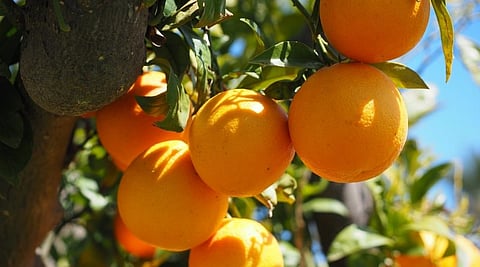
- Home
- Live Blog
- Breaking News
- Top Headlines
- Cities
- NE News
- Sentinel Media
- Sports
- Education
- Jobs

A CORRESPONDENT
BISWANATH CHARIALI: The commercial cultivation of six varieties of sweet orange (Citrus sinensis), namely Valencia, Westin, TM-33, Cutter Valencia, Pera, and Natal, has been started at Biswanath Chariali, on the north bank of the state, by the ICAR-Central Citrus Research Institute (CCRI), Nagpur, with a view to meeting the growing demand of this delicious fruit.
According to information, Khasi Mandarin and Assam Lemon dominate the commercial citrus cultivation in the region, though their cultivation shares only 5.41% and 3.49% of the country’s total citrus area and production, respectively. The current demand for the citrus fruits in the state is met by supplies from other parts of the country, mainly Nagpur and Punjab.
The research work being carried out by ICAR-CCRI, Nagpur, for the last couple of years has established the importance of several varieties of sweet oranges. Following this, these varieties were cultivated by the Regional Research Centre for Citrus (RRCC) at Biswanath Chariali to observe their performance under the prevailing climatic conditions of the region. It may be mentioned here that the regional centre was set up by the ICAR-CCRI in 2017.
Talking to this correspondent, Senior Scientist of the RRCC at Biswanath Chariali, Dr Eveining Stone, said, “The sweet orange is non-traditional in the Northeast, particularly in Assam, and it possesses huge potential. The sweet orange varieties evaluated at Biswanath Chariali, located in the North Bank plain zone of Assam, have shown considerable promise.” These varieties exhibit different maturity periods, ranging from early-maturing varieties like TM-33 and Westin (October) to late-maturing types like Cutter Valencia and Natal (January-February).
“The variation in maturity offers the opportunity to extend the fruit’s availability over a longer period,” he added.
Cutter Valencia and Valencia, being less seeded varieties, are highly suitable for processing, while others can cater to the fresh fruit market. “The integration of these sweet orange varieties into Northeast India’s citriculture not only strengthens the regional citrus industry but also adds valuable crop diversity, contributing to both economic and agricultural growth in the region,” Dr. Stone further disclosed. At the beginning, the centre had started cultivation of 39 varieties, but only six varieties survived in an area measuring around 10 hectares.
Also read: Assam’s lemon, Meghalaya’s orange agri products go international
Also watch: